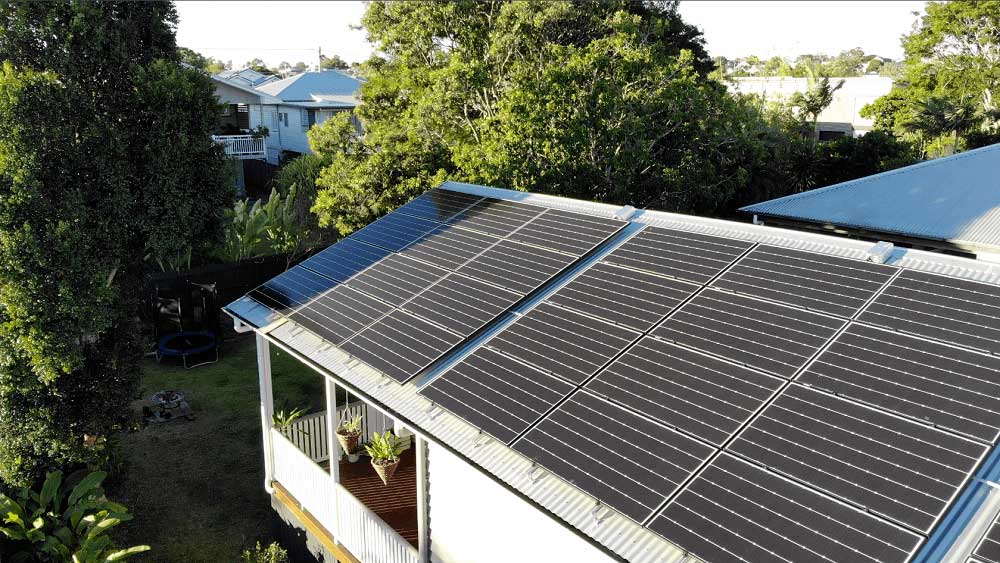How home solar energy systems work

Residential solar energy systems can save you money and are good for the environment but how do they work?
It starts with the solar panels, the most visible element of your system that all Queenslanders will be familiar with.
Nearly every street in the state will have a house with panels on its roof delivering solar energy to power appliances in the home.
Solar panels work by generating DC (direct current) electricity as sunlight, or solar irradiation, stimulates electrons to move though solar cells on the solar panels.
It is sunlight, not heat, that generates the electricity.
Household appliances require AC (alternating current) electricity to operate, so solar panels send their DC electricity into an inverter that converts it into AC current.
Your inverter sends AC solar electricity to your main switchboard, which in turn sends it to your home’s appliances, giving you free power.
Any excess power generated during the day is fed back into the main grid. A State Government scheme means you will usually be paid a feed-in tariff from your electricity retailer for any excess power your system generates.
Your smart meter, installed as part of the system, will record and track all energy flows. It will automatically feed the excess solar electricity into the grid.
The smart meter also allows your home to automatically draw power from the grid when needed, such as at night.
Nearly every roof in Australia is suitable for solar panels.
Most residential roofs in Australia are constructed out of metal or tile.
Metal is the cheapest roof to install a solar system on while tile roofs can often have extra installation costs.
Different roof pitches, or angles, can affect the performance of your solar panels.
The best way to maximise the efficiency of your solar panels is to have an inclined angle of about 10 degrees above horizontal to prevent rain and other dirt from accumulating.
If your roof is either flat or very steep, your solar system may require tilt frames (and additional expense) for optimum sun exposure.
Solar panels are relatively light, but with the average system size increasing to at least 6kW, 20 or more panels can have a significant weight factor, so it is crucial for solar technicians to assess your roof before installation.
Some roofs may not be strong enough for solar panels. In this case, additional frame structure may be necessary before installation.
Ideally, your roof allows panels to face north, west, or east. Since south-facing panels receive less sun exposure in Australia, they are generally not recommended.
If you live in a part of Queensland which can be affected by cyclones, you will need to have a cyclone-certified solar mounting system.
Sources: Australian Energy Foundation, GEM Energy.
Related topics
Things to note
The information in this article has been prepared for general information purposes only and is not intended as legal advice or specific advice to any particular person. Any advice contained in the document is general advice, not intended as legal advice or professional advice and does not take into account any person’s particular circumstances. Before acting on anything based on this advice you should consider its appropriateness to you, having regard to your objectives and needs.
Insurance Products (excluding Travel Insurance) are issued by RACQ Insurance Limited ABN 50 009 704 152 (RACQI) and arranged by its agent, RACQ Distribution Services Pty Ltd (RDS) ABN 35 116 361 650, AFSL 567130 and RDS' authorised representatives (including RACQ Operations Pty Ltd ABN 80 009 663 414, AR No. 234978 (RACQO). Conditions, limits and exclusions apply. RDS and RACQO are in the RACQ group of companies. One of the companies in the RACQ group of companies has a minority shareholding in RACQI.
RDS and RACQO have not taken your personal objectives, circumstances or needs into account when preparing advice regarding insurance products and you will need to consider whether the advice is appropriate for you. Read the Product Disclosure Statement (PDS) and any applicable Supplementary PDS before making a purchase decision on this product. You can also access our Target Market Determinations on this website. RDS receives a commission from RACQI for the policies it arranges. RACQO receives fees paid for services it provides to RDS. Further details about remuneration are available on request prior to purchasing.
Banking and loan products issued by Members Banking Group Limited ABN 83 087 651 054 AFSL/Australian credit licence 241195 trading as RACQ Bank. Terms, conditions, fees, charges and lending policies apply. This is general advice only and may not be right for you. This information does not take your personal objectives, circumstances or needs into account. Read the disclosure documents for your selected product or service, including the Financial Services Guide and the Terms and Conditions, and consider if appropriate for you before deciding.
Except for RACQ Bank, any RACQ entity referred to on this page is not an authorised deposit-taking institution for the purposes of the Banking Act 1959 (Cth). That entity’s obligations do not represent deposits or other liabilities of RACQ Bank. RACQ Bank does not guarantee or otherwise provide assurance in respect of the obligations of that entity, unless noted otherwise.
RACQ Bank subscribes to the Customer Owned Banking Code of Practice which establishes higher standards than the law requires. The Code reflects modern consumer expectations and developments in approaches to issues such as consumer vulnerability, guarantors, and supporting customers through financial hardship. Please read our Customer Owned Banking Code of Practice page for more information.
RACQ Operations Pty Ltd (ABN 80 009 663 414 AR 000234978) and Members Travel Group Pty Ltd (ABN 45 144 538 803 AR 000432492) are acting as an Authorised Representative of the issuer of the insurance, Tokio Marine & Nichido Fire Insurance Co., Ltd. (ABN 80 000 438 291 AFSL 246 548). Any advice set out above is general in nature only, and does not take into account your objectives, financial situation or needs. Before purchasing any travel products, please consider the RACQ Travel Insurance Product Disclosure Statement (PDS) and the Target Market Determinations (TMDs) that apply to these products. Whilst the PDS outlines the Terms and Conditions of these products, the TMDs outline the intended class of customers that comprise the target market for these travel products. This will allow you to consider which products best suit your objectives, financial situation and needs and consider the products appropriateness to your personal circumstances. TMDs also outline matters involving the distribution and the review of these products. The PDS, Supplementary PDS and TMDs for each travel product can be found here.

